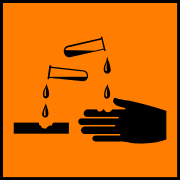|
Bases constitute a class of compounds that are considered to be the chemical opposite of acids. |
|
Bases
Bases are the chemical opposites of acids. Strong bases are corrosive substances with a greasy slippery feel.
Bases contain ions that can neutralise (react with and cancel out) the H+ ions of the acids, such as the hydroxide ion, the oxide ion and the carbonate ion.
| basic ion | formula |
| hydroxide | OH- |
| oxide | O2- |
| carbonate | CO32- |
| hydrogen carbonate | HCO3- |
| sulfate(IV) | SO32- |
Neutralisation
Just as acids neutralise bases, so bases neutralise acids by reacting with the H+ ions of the acidic solution. In all neutralisation reactions water is formed:
| Base | neutralisation |
|---|---|
| hydroxide |
OH- + H+ |
|
oxide
|
O2- + 2H+
|
|
carbonate
|
CO32- + 2H+
|
|
hydrogen carbonate
|
HCO3- + H+
|
|
sulfate(IV)
|
SO32- + 2H+
|
Alkalis
Alkali is simply the term given to a soluble base, such as sodium hydroxide, potassium hydroxide or barium hydroxide.
Ammonia
Ammonia has the molecular formula NH3. It is a pungent (sharp) smelling gas that is used in household cleaners. It is very soluble in water giving a solution of about pH 10.
Ammonia gas dissolves in water to give a solution that behaves as a base in that it neutralises acids producing a salt and water. The reason for this is that the ammonia molecule partially removes some of the hydrogen ions from water leaving the solution with an excess of OH´(hydroxide ) ions. These ions can then react with acids.
|
ammonia
|
+ |
water
|
|
ammonium ions
|
+ |
hydroxide ions
|
|
NH3
|
H2O
|
NH4+
|
OH-
|
This equilibrium reaction lies very much to the left hand side, meaning that there is much more of the molecular form of ammonia in the solution than there is of the ions.
However, any reaction of the hydroxide ions removes them from the equilibrium which responds (Le Chatelier, take from the right hand side, make more of the right hand side) by making more. Thus, any reaction which neutralises the OH- ions goes all the way to completion.
Ammonia reactions
|
sulfuric acid
|
+ |
ammonia
|
→
|
ammonium sulfate
|
|
H2SO4
|
2NH3
|
(NH4)2SO4
|
||
|
hydrochloric acid
|
+ |
ammonia
|
→
|
ammonium chloride
|
|
HCl
|
NH3
|
NH4Cl
|
||
|
nitric acid
|
+ |
ammonia
|
→
|
ammonium nitrate
|
|
HNO3
|
NH3
|
NH4NO3
|
||
|
ethanoic acid
|
+ |
ammonia
|
→
|
ammonium ethanoate
|
|
CH3COOH
|
NH3
|
CH3COONH4
|
Note: There is no water formed in the reaction. Some textbooks refer to a solution of ammonia in water as 'ammonium hydroxide' solution, NH4OH, in which case there will be water formed when it reacts with acids.
Indicators
Indicators may be used to test for bases in the same way as they are used to test for acids (only with different colours of course)
Common indicator colour changes are:
|
medium
|
Universal indicator
|
Litmus
|
Phenolphthalein
|
|
Neutral
|
|
|
|
|
Basic
|
|
|
|
Bases register values from 7 (neutral) to 14 on the pH scale.


